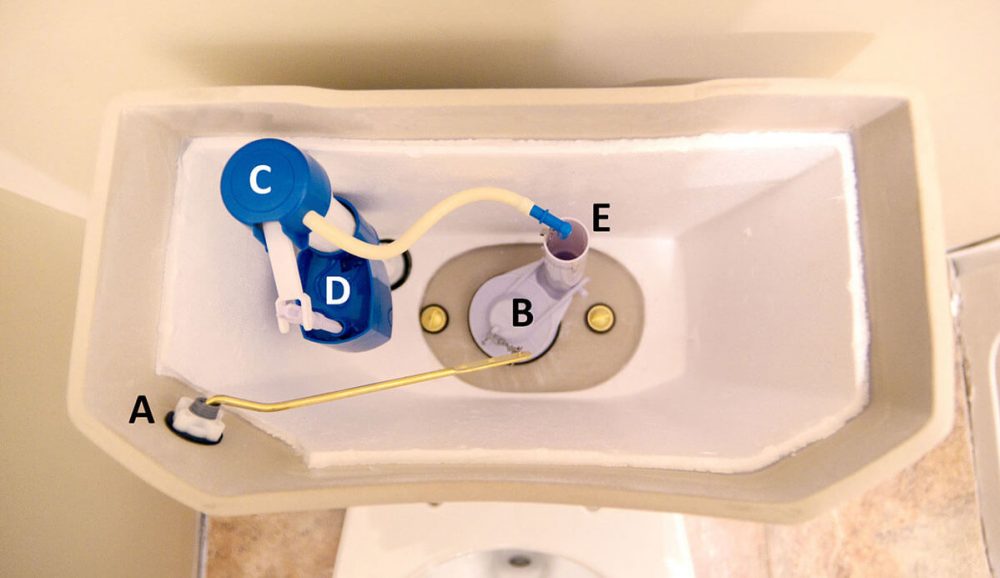Why Won’t My Toilet Stop Running?
When the toilet is continually running, you are potentially wasting gallons of water and creating a higher water bill. No need to worry, a running toilet is usually a simple fix. The three most common causes are a broken or dirty flapper, too long or too short of a chain between the flush lever and the flapper or a float that is out of position.
The first thing you will need to do is turn off the water feeding into the toilet. Find the silver knob on the back of the wall behind the toilet and turn it to the right. Second, take off the tank lid and start to identify all the components and how they all work together.
A. The toilet flush lever (on the outside) is connected to the rubber flapper (inside).
B The rubber flapper stops the tank water from going into the bowl.
C. The pump is what refills the tank after a flush.
D. The float raises and lowers with the water level to tell the pump when to stop.
E. The overflow tube sets where the water level should be in the tank.

Cause 1 – Flapper Chain
First, make sure the chain is connecting the flush lever and the rubber flapper correctly. Sometimes the chain will become disconnected. Next, shake the flush lever and see if there is too little or too much slack in the chain. If it’s too short, water will continue to leak into the bowl because the flapper isn’t sealed. If it’s too long, the chain won’t open the flapper when the lever is pushed. If you need to, cut off the excess chain. The chain may also have a float attached to it, adjust the float so that it sits on top the water’s surface.
Cause 2 – Dirty or Broken Flapper
Over time, the flapper may not seal the drain properly because it has become dirty, warped or broken. If you need to clean or replace it, first completely drain the tank and then unhook it from the chain. The store will have a variety of replacement options. If you can, match the brand or find a “universal” label that looks close to what you have. After you have reattached the flapper, test it with water to see if it seals correctly.
If you find that the flush valve (what holds the flapper in place) may be the cause of a water leak and needs replaced, read these step by step instructions.
Cause 3 – Float out of Position
The water level inside the tank is controlled by an adjustable float. If the float is set too low, it creates a weak flush. If it’s set too high, water will spill into the overflow tube and continually run. Look for a fill level mark on the inside back of the tank and mark it on the overflow tube so it’s easily seen. If you don’t see a mark, measure approximately 1 inch down on the overflow tube and make a mark.
Next, turn on the water and flush the toilet to see where the water level stops in comparison to the mark. If the water goes over, then the float for the pump is too high. Adjust the float up or down accordingly. On an older toilet, you may need to bend the brass rod that’s connected to the float. Newer toilets only require you to turn a screw or slide a clip along a rod. Sometimes, the fill valve (what the float connects to) won’t actually shut off and may be defective. In this case, you will need to buy a replacement valve.
If your toilet continues to run and these solutions don’t solve the problem, call the professionals at Bailey Brothers Plumbing at 405-896-9988. Our experts will get your toilet up and running quickly and correctly.
